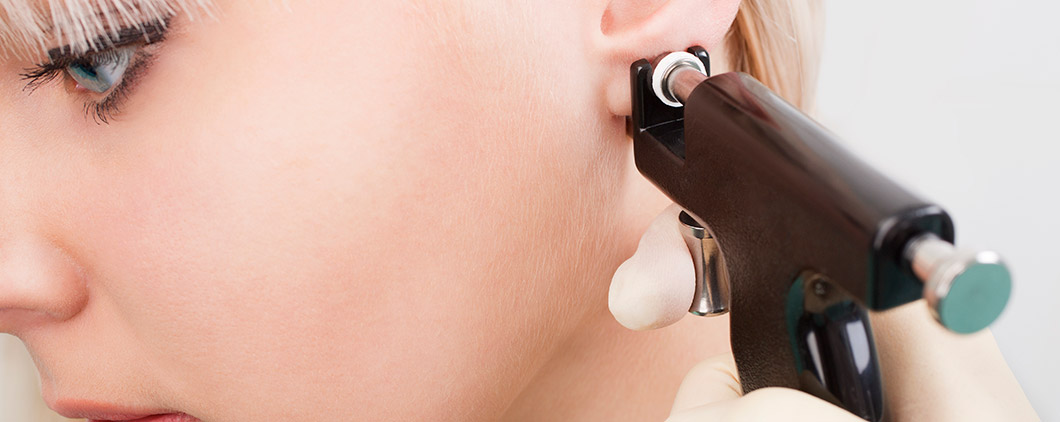
Services that break the skin, such as ear piercing, tattooing and micropigmentation, are risk factors for blood-borne infections such as Hepatitis B, Hepatitis C and HIV. Infection control precautions must be followed to protect both personal service workers and clients.
Infection prevention and control precautions must be followed to protect both personal service workers and clients. You do not have to see blood or bodily fluids on the instruments for an infection to occur.
The following is in addition to general operational requirements according to Ontario Regulation 136/18 Personal Service Settings.
Ear Piercing Equipment
- Ear piercing instruments must not be used on any other part of the body except the ear lobes (fleshy part only), as the instrument can damage tissue and create a risk of infection.
- If a needle or dermal punch method is used for piercing the ear lobe, the requirements of body piercing must be met.
- Ear piercing instruments without sterile, single use disposable adapters or cartridges (i.e. fixed stud adapter and clasp retainer) or ear piercing equipment that cannot be sterilized, must not be used.
Jewellery
- Jewellery must be supplied pre-packaged and sterile.
- Under no circumstances can the jewellery be sampled or returned.
- Previously opened packages of jewellery can no longer be considered sterile.
- Any jewellery stored in opened or damaged packages cannot be used to pierce the ear lobe.
- Do not spray sterile earrings with disinfectant prior to piercing.
Infection Prevention and Control Requirements
Steps to Piercing the Ear Lobe
- Obtain client information for record keeping purposes.
- Practice hand hygiene before and after each client:
- Use hand sanitizer (60-90% alcohol) if your hands are not visibly dirty; or
- Clean your hands with soap and water if your hands are visibly dirty.
- Check the client’s skin to ensure it is free from any cuts, wounds, rash or visible infections.
- Do not provide service if there are visible skin conditions and advise the client to seek medical attention.
- Never offer to treat any skin conditions.
- The ear piercer must wear single-use disposable gloves on both hands during the procedure.
- Gloves must be changed between clients, and breaks in service (e.g. leaving the station) of the same client.
- Clean the front and back of the ear lobe with an approved skin antiseptic.
- Mark the ear lobe with an aseptic technique to prevent contamination of the marking pen.
- If using a reusable pen, the ear must be cleaned as in step #5, marked and allowed to dry, then cleaned again.
- Load the ear piercing instrument without touching either the sterile jewellery or the stud-holding sterile devices on the instrument.
- Pierce the ear lobe with the sterile jewellery.
- Discard all disposable parts (i.e. cartridges/adaptors and leftover jewellery in opened packages).
- Remove gloves and practice hand hygiene.
- Provide verbal and written after care instructions to the client that includes how to care for the piercing.
- Clean and disinfect the ear piercing gun with an intermediate to high level disinfectant between clients.
- Store the ear piercing equipment in a clean enclosed container to prevent contamination and avoid touching the device unless hands are washed and single-use disposable gloves are worn.
Cleaning and Disinfection
- Ear piercing instruments with sterile, single-use disposable parts, must be cleaned with soap and water, and then disinfected with an intermediate to high level disinfectant for the appropriate contact time (i.e. 70% isopropyl alcohol for 10 minutes), after each client.
Note: Ear piercing instruments without sterile, single use disposable adapters or cartridges (i.e. fixed stud adapter and clasp retainer) or ear piercing equipment that cannot be sterilized, must not be used.
- Store piercing instruments in a clean, covered, non-absorbent container when not in use.
Record Keeping
The following records must be kept on site for a minimum of 1 year and readily available in a secure location for at least two years after the procedure:
- Accidental blood exposures
- The full name of every client who has received an ear piercing as well as the date of the procedure, mailing address and telephone number, name of the person who performed the piercing, and details of the procedure that was carried out.
For piercing parts of the body other than the ears, review the Body Piercing webpage.
For more information, please contact the Environmental Health Department at 519-258-2146 ext. 4475 to speak with a Public Health Inspector.
Record keeping forms can be found here.
Resources
Ciphi Ontario Fact Sheet (2011). Ear Piercing with Hand-held Devices

